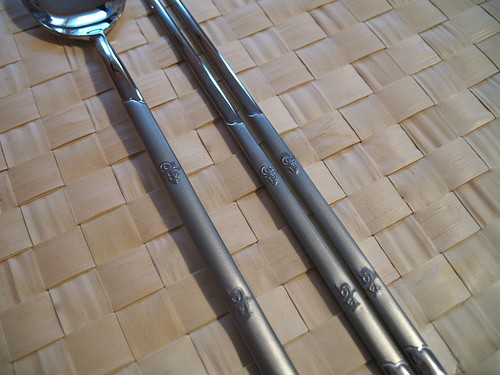
As promised, today's edition of Ethnic Eating 101 concentrates on the two temperature extremes in Korean food: soon tofu, which is served literally boiling hot, and naengmyeon, which is served literally ice cold. No matter what the weather, there is a Korean dish perfect for it.
Before we start, a word about Korean tableware. Koreans use spoons at every meal and they are the only Asian culture which consistently uses metal chopsticks (usually stainless steel). If you're new to the art of chopstickery, you are going to be one frustrated diner after trying to pick up food with heavy metal chopsticks. They usually have raised bumps or grooves near the tips to assist with traction, but that's no guarantee of success.
]
Fortunately, Koreans don't use chopsticks for quite as many tasks
as other Asians; rice, for example, is normally eaten with a spoon (or
dumped into a pot of stew and then eaten with the spoon–this is not
the etiquette horror it might be elsewhere), so the chopsticks are
really only used for non-soupy, non-rice foods, which tend to be easier
to eat with slippery metal. As long as you can eat it neatly with a
spoon, you are OK manners-wise.
Why metal, incidentally? There's
no canonical answer to the question; one of the more plausible theories
seems to be that of the servers at Beverly Tofu House in L.A.'s
Koreatown: Koreans use metal chopsticks because Koreans use metal
spoons and Koreans like their utensils to match. This would explain the
use of metal soup bowls and metal rice bowls as well.[Soon tofu
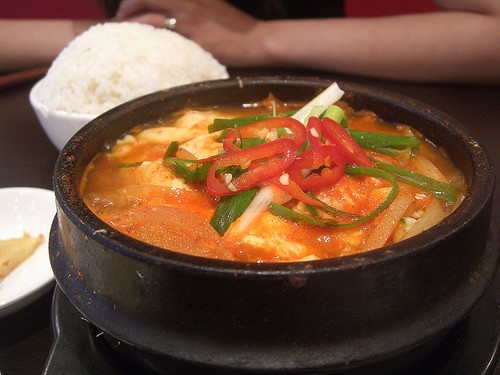
Soon
tofu (properly sundubu jjigae, literally “uncurdled tofu stew”) is a
cauldron of boiling, roiling stew containing your choice of protein,
broth, an impressive amount of gochujang (a chile paste made with rice
powder and fermented soybeans), vegetables (always including green
onions) and a big dollop of soft tofu. The dish is served in a dolsot
(stone pot) while it is still boiling.
What protein you get is
entirely up to you. Vegetarians can choose to skip the meat (but ensure
that there is no meat broth in the stew); beef, chicken and shrimp are
very common, but be aware that the shrimp will likely come in the same
shape it was fished out of the ocean, antennae and all. My favorite is
clams; there's some magic reaction between the stew and the clamshell
that lends a very, very faint, almost metallic tang to the broth. The
clams open when the stew is poured over, and by the time they cool
enough to eat they're perfectly cooked, tender and not chewy at all.
Soon
tofu is served with chopsticks and spoons. Don't let anyone fool you;
if you try to eat soon tofu with chopsticks you will fail miserably and
probably burn yourself in the process. The chopsticks are for the
banchan; the spoon is for the stew and rice.
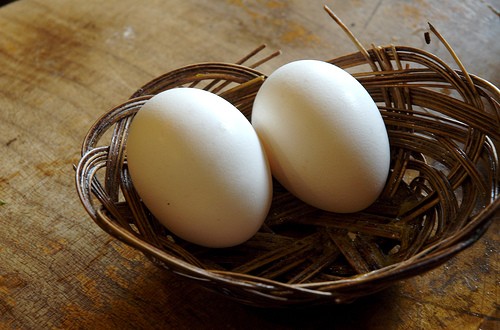
You may notice that
the server gives you a small bowl of eggs. These are raw eggs; crack
one on the table (so you don't get shell fragments in your food) and
open it into the dolsot as soon as you get it. Stir a bit with the
spoon. The boiling heat will cook the egg and lend a creamy, rich taste
to the stew.
Soon tofu is eaten with rice; if you've ordered it
very spicy, you will want the rice to cut the chile heat. As with other
meals, you may get rice in a dolsot or just in an individual, lidded
metal bowl. BCD, for example, serves dolsot rice; Kaju serves
metal-bowl rice. Feel free to put some rice in the stew; Koreans do it
all the time.
The perfect accompaniment to soon tofu is an
ice-cold glass of poricha (barley tea). Some places bring it out by
default, but you may need to ask for it. While it takes a few sips to
get used to, you'll find that nothing else quenches the thirst brought
on by salty, spicy food as well as poricha. If you've still got a mouth
full of chile heat, most soon tofu places either have dispensers of
sticky sweet fruit ice near the door (with small cups, help yourself)
or they'll simmer ginger and water and a little sugar in your rice pot
to calm your stomach.
Where to get this: Kaju Tofu (8895 Garden Grove Blvd., Garden Grove; 5408 Walnut Ave., Irvine; 7922 Valley View, Buena Park) is the local favorite. BCD Tofu House (9520 Garden Grove Blvd., Garden Grove; 11818 South St., Cerritos) is not as well-loved but is open 24 hours a day. South Countians can also head for Kaya (14120 Culver Dr., Irvine), where you can have p'ajeon (scallion pancake) as one of your banchan.[Naengmyeon
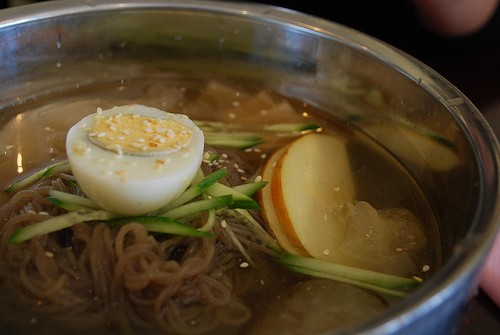
While soon tofu is a hearty, comforting dish in winter (as evidenced by
the lines when it's cold and dreary), September and its parched dry
heat pushed out by relentless Santa Ana winds call for a different
Korean solution, the iced noodles called naengmyeon.
Bizarrely,
naengmyeon (literally “cold noodles”) was traditionally a winter dish
in North Korea, which is not exactly known for its pleasant beach
weather in January. It has jumped the DMZ over the last few decades and
South Koreans slurp it up by the bowlful in summer. You may see signs
advertising “Pyongyang-style” or “Hamhung-style” naengmyeon, just like
seeing signs advertising “New York-style” pizza.
The most common
version of naengmyeon, and the one that makes any hundred-plus degree
day bearable, is called mul naengmyeon (remember, “mul” means “water”).
Mul naengmyeon is a bowl of noodles (nearly always buckwheat, but
occasionally kudzu starch) topped with half a hard-boiled egg, raw
vegetables including cucumber and carrot, a couple of small slices of
beef and a thin slice or two of Korean pear. This pile of goodness is
topped with ice-cold beef broth. Ice cold, incidentally, is not an
exaggeration: you may have to move the ice out of the way to get the
solid food out.
You'll be given squeeze bottles with your mul
naengmyeon; one contains sinus-clearing mustard (called gyeoja) and the
other contains tangy rice-wine vinegar (called shikcho). Add a little
bit of both to your broth and stir. They lend interest to what would
otherwise just be a giant cold bowl of soup. Eat mul naengmyeon using
your chopsticks for the solid food and your spoon for the broth.
The
best mul naengmyeon has stock that has gelled very slightly; this means
it was made properly, with roasted beef bones simmered for hours in
water and allowed to cool. The slightly jellied texture is because
bones contain gelatin, which dissolves into the flavored water and then
re-forms slightly.
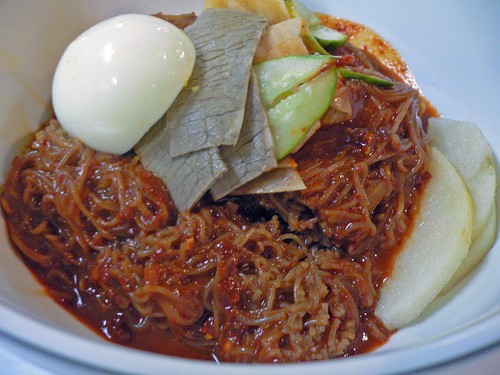
The other principal kind of naengmyeon is
called bibim naengmyeon (literally, “mixed cold noodles”). This is most
of the same ingredients as mul naengmyeon, but served cold with a
squeeze bottle of gochujang (hot pepper paste). You mix the noodles and
gochujang and eat it as-is. When you encounter bibim naengmyeon, it may
be served with a side bowl of the same ice-cold stock as mul
naengmyeon; if not, feel free to ask for it, as well as vinegar and
mustard; it is very refreshing.
When being served naengmyeon,
you may be asked if you want your noodles cut. Buckwheat noodles are
famously chewy and it can be an impolite scene to gnaw off the noodles.
These are not Chinese longevity noodles, and you won't be cutting your
life short (even superstitiously) if you let the server cut your
noodles with clean scissors.
Look around at people eating
naengmyeon and you will see bottles of fizzy Korean beer, usually Hite
or O.B. brand; it is a very popular accompaniment. Incidentally, most
places do not serve banchan (other than perhaps a small plate of
kimchi) with naengmyeon; it's meant to be a light meal, as though
anything served in such huge portions could ever be called “light”.
Where to get it? Despite its self-identification as a barbecue restaurant, Shik Do Rak (9691 Garden Grove Blvd., Garden Grove; 14775 Jeffrey Rd., Irvine) serves an excellent version of mul naengmyeon. Morangak (9651 Garden Grove Blvd., Garden Grove) also has a decent version. For bibim naengmyeon, however, the stone-cold (sorry) winner is Ham-Hung Restaurant (10031 Garden Grove Blvd., Garden Grove)–look for the wooden door. You can have your bibim naengmyeon with cold skate, or with cold beef.
Next
week, it's time for the licorice-all-sorts of Korean food, a mixed rice
dish with as many as ten toppings; Korean fried chicken; and the
silent-but-deadly liquor soju and the dishes that go with it.

